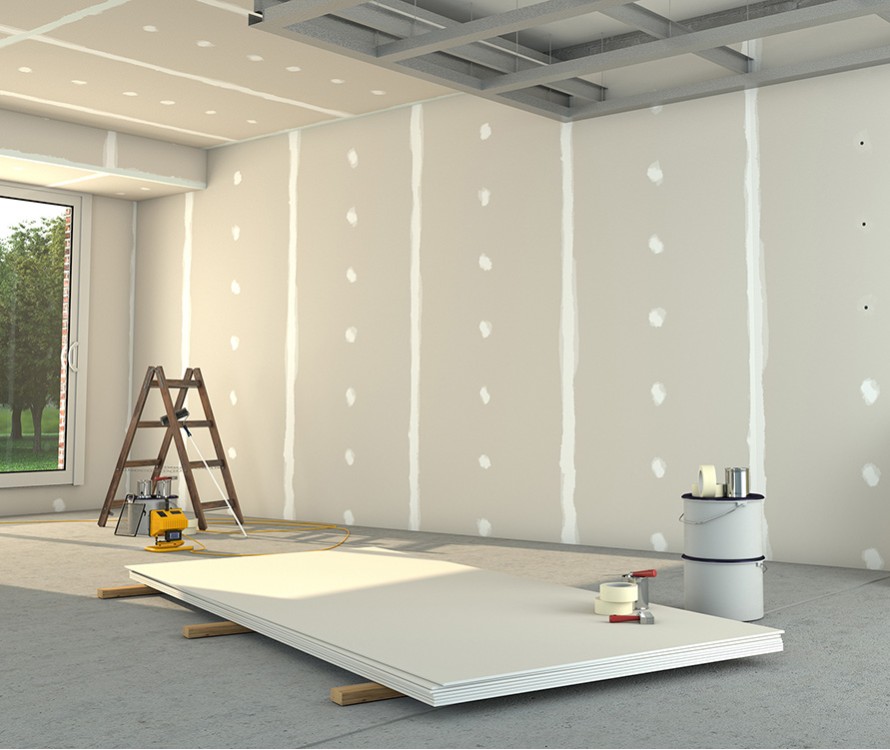Plasterboarding and Metal Stud Work for Modern Interiors

2 February, 2024
In the world of construction and interior design, the use of plasterboard and metal stud work has become increasingly popular for creating sleek, modern, and versatile spaces. These materials offer several advantages, such as ease of installation, durability, and the ability to achieve a smooth and seamless finish. In this article, we will delve into the world of plasterboarding and metal stud work, exploring their benefits, applications, and tips for achieving professional results.
Understanding Plasterboarding:
Plasterboard, also known as drywall or gypsum board, is a widely used building material composed of gypsum sandwiched between two layers of paper. Its popularity can be attributed to its versatility, cost-effectiveness, and fire-resistant properties. Plasterboard is commonly used for interior walls and ceilings and can be applied to both timber and metal stud frameworks.
Benefits of Plasterboarding:
Quick Installation: One of the key advantages of plasterboarding is its rapid installation process. When compared to traditional plaster and lath construction, plasterboard significantly reduces construction time, making it a preferred choice for both residential and commercial projects.
Smooth Finish: Plasterboard provides a smooth and even surface, ideal for achieving a flawless finish. This feature makes it an excellent canvas for various decorative treatments such as paint, wallpaper, or texture coatings.
Sound Insulation: Plasterboard contributes to sound insulation, enhancing the acoustic performance of a space. This makes it a preferred choice for rooms that require privacy or reduced external noise.
Fire Resistance: Gypsum, the main component of plasterboard, is inherently fire-resistant. This property adds an extra layer of safety to buildings, making it a popular choice for meeting fire safety regulations.
Metal Stud Work:
Metal studs are structural framing components used to create the framework for plasterboard installations. Typically made of steel, these studs offer several advantages over traditional timber framing.
Benefits of Metal Stud Work:
Durability: Metal studs are resistant to rot, mold, and pests, providing a longer lifespan compared to timber studs. This durability makes them a reliable choice for both residential and commercial construction.
Consistency: Metal studs are manufactured with precision, ensuring uniform dimensions and straightness. This consistency makes them easy to work with and results in a more accurate and professional-looking finished product.
Space Efficiency: Metal studs are thinner than their timber counterparts, maximizing the usable floor space in a room. This feature is especially crucial in smaller spaces where every inch counts.
Environmentally Friendly: Steel used in metal studs is a recyclable material, making metal stud work an eco-friendly option for sustainable construction practices.
Tips for Successful Plasterboarding and Metal Stud Work:
Proper Planning: Begin by carefully planning the layout of the metal studs, ensuring they are spaced correctly and aligned for optimal support.
Use the Right Tools: Invest in quality tools, such as a screw gun, level, and drywall saw, to ensure precision and efficiency during installation.
Consider Electrical and Plumbing Needs: Before installing plasterboard, plan for electrical and plumbing requirements, as metal studs allow for easier integration of these systems.
Joint Finishing: Pay attention to joint finishing techniques to achieve a seamless and professional-looking result. Proper taping, mudding, and sanding are essential for a smooth finish.
Conclusion:
Mastering the art of plasterboarding and metal stud work is a valuable skill for construction professionals and DIY enthusiasts alike. The combination of plasterboard's versatility and metal stud work's durability opens up a world of possibilities for creating modern and aesthetically pleasing interiors. With the right techniques and attention to detail, these materials can transform any space into a work of art.
